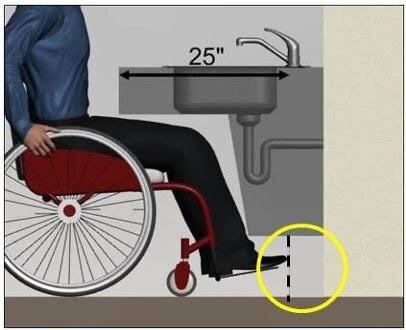
All restrooms in commercial spaces must follow the minimum standards issued under the Americans with Disabilities Act (ADA). It must be universally accessed by people with vision or hearing impairments, mobility problems, and other physical problems. There should be at least one lavatory, one urinal, and one closet with privacy latches.
The standard requirements for bathrooms are based on the unique needs of people in wheelchairs, but with additional considerations for all types of disabilities.
In this article, we will help you understand the requirements for your restroom accessories and sinks so you can design your ADA-compliant bathroom.
To create an ADA-compliant bathroom design, you need to include at least one sink that complies with the minimum standards requirements. Sinks should have at least 30 x 48 inches of centered clear floor space, required toe and knee clearances not included.
The sinks on the countertop should be as close as possible to the rim so that an individual can have maximum accessibility. The highest point from the countertop or the front edge of the sink should have a maximum height of 34 inches above the finished ADA bathroom floor.
Also, as part of ADA requirements, every exposed surface and bathroom pipe underneath the sink must be insulated and designed to protect any user against contact. This means using removable protective panels, installing wrapped pipes, and removing abrasive surfaces or sharp objects.
There should be at least 9 inches of toe clearance from underneath the sink to the finished floor, extending to a full width of at least 30 inches of clear floor space. As for the depth, toe clearance should be 17 to 25 inches, starting from the front rim of the ADA sink.
Knee clearance is the area below the sink that extends 9 to 27 inches above the floor.
The required knee clearance is a maximum depth of 25 inches, just below the front rim of the sink, extending to a full width of at least 30 inches of clear floor space. From a height of 27 inches above the bathroom floor, the clearance depth should be at least 8 inches from the front rim of the sink.
From a height of 9 inches above the floor, the clearance depth should be at least 11 inches from the front rim of the sink. As for the slope of the clearance, for every 1 inch in depth, the height of the knee clearance can be reduced to a maximum of 6 inches.
Every restroom accessory should be entirely recessed into the wall for all ADA-compliant bathrooms so that universal accessibility can be achieved. Accessories should be installed over 27 to 80 inches above the finished restroom floor, and should project a circulation path with a maximum of 4 inches.
If the recessed accessories are at or below 27 inches, then it can project any measure, considering that the required reach range and clear space are maintained.
Surface-mounted and floor-mounted accessories that protrude over 4 inches should be placed on alcoves, corners, or in between structural pieces so they will be out of the way.
Building ADA-compliant bathrooms and accessories involves a lot of factors as required by the ADA standards. This is to make sure that all bathroom users, including those in wheelchairs and people with disabilities, can easily access every element of your commercial bathrooms.
All Things Inspector is the #1 E-learning marketplace with a blog, and online store for specialty equipment such as tools for ADA-compliant bathrooms. Learn more about how you can quickly check for knee clearance and ADA compliance. Contact us today!

Certain tools must be in an ADA inspection tool kit without fail. These tools are essential in carrying out an ADA inspection. They include a

The Americans with Disability Act (ADA) is a federal law that is against discrimination against individuals with disabilities. This law is designed to ensure equal
